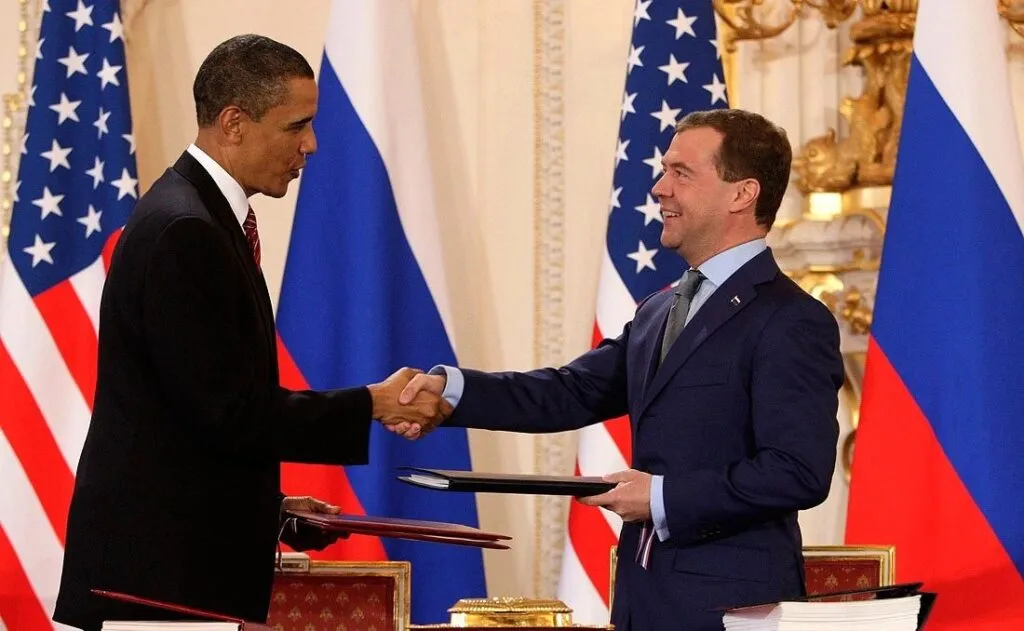Risk reduction can help prevent nuclear crises. Here’s how.
By Shawn Rostker | March 22, 2024
 Then-US President Barack Obama and then-Russian President Dmitry Medvedev sign New START—the US-Russian treaty that limits their deployed long-range nuclear forces—in Prague in April 2010. In 2023, Russia suspended its participation in New START and revoked its ratification of the Comprehensive Nuclear-Test Ban Treaty. (Photo by Kremlin.ru)
Then-US President Barack Obama and then-Russian President Dmitry Medvedev sign New START—the US-Russian treaty that limits their deployed long-range nuclear forces—in Prague in April 2010. In 2023, Russia suspended its participation in New START and revoked its ratification of the Comprehensive Nuclear-Test Ban Treaty. (Photo by Kremlin.ru)
On February 4, 2026, the New Strategic Arms Reduction Treaty (New START), the last legally binding arms control agreement on strategic nuclear warheads, will expire, ushering in a theoretically unconstrained nuclear world.
Treaty-based bilateral arms control has been valuable for managing military competition and reducing the risk of nuclear use. But it is not the only instrument for doing so. In a period of erosion of the treaty-based arms control architecture, other tools are needed that capture strategic restraint, limit destabilizing capabilities, and prevent crises from spilling over into conflict. One of them is risk reduction.
Risk reduction can foster cooperation on limitations and quantitative reductions of nuclear weapons. Most important, risk reduction measures can help avoid worst outcomes by channeling strategic competition toward restraint and transparency while reducing ambiguities that can lead to misunderstanding and miscalculation.
Risk reduction measures can include actions taken unilaterally, bilaterally, or among multiple countries to lower the possibility of nuclear weapons use and reduce the chances for crises to spiral into conflict. Risk reduction is not, however, a substitute for a comprehensive national security strategy. For potential conflicts arising out of countries’ natural willingness to compete for strategic interests, a credible policy of deterrence remains necessary to underpin risk reduction efforts. For instance, National Security Advisor Jake Sullivan asserts that deterring hostile and revisionist behavior will be a topline demand in the coming years that will put pressure on cooperative efforts.
But deterrence and risk reduction are not mutually exclusive and should be pursued in tandem.
A risk-reduction framework aims to prevent countries from engaging in aggressive behaviors and strategies that rely on opaque and competitive postures and that emphasize the use of military force. They should supplement rather than replace formal agreements. A risk-reduction approach can cultivate a basis of trust between parties when formal agreements represent too ambitious a goal. They can do this by enhancing communication, establishing predictability, and building confidence through unilateral and reciprocal demonstrations of restraint such as mutual moratoria on particular behaviors or voluntary disclosures of information.
There are three areas in which countries can reduce nuclear risks in the absence of more traditional arms control cooperation.
First, risk reduction efforts must be focused on reducing the possibility of accidental, inadvertent, or unauthorized use of nuclear assets. To that end, the US “failsafe review” can serve as a model for how nuclear weapons states can take effective unilateral steps to strengthen safeguards and secure stockpiles. (The review is an assessment aimed at ensuring that the systems, procedures, and policies governing nuclear weapons are secure, reliable, and capable of preventing unauthorized or accidental use.) A thorough internal review of the nuclear enterprise is something that each nuclear-armed country can undertake that would improve the overall safety of nuclear weapons, strengthen the institutional ligaments responsible for their stewardship and maintenance, and clamp down on possible proliferation pathways. It would expose potential gaps in command-and-control procedures and technical vulnerabilities arising from the integration of cyber systems or other emerging technologies, as well as highlight the need for any redundancy measures.
Individual commitments to undertake such reviews would breed confidence among both nuclear and non-nuclear weapons states that nuclear weapons possessors are committed to preventing nuclear accidents and the unauthorized proliferation of nuclear capabilities. Moreover, these benefits would not come at the expense of openly revealing vulnerabilities, although it would be a useful confidence-building measure to share unclassified top-level findings. The United States can lead by example by encouraging other nuclear weapons states to undertake their own failsafe reviews and come to the table with their own lessons learned.
Second, risk reduction measures must address the military tensions exerting pressures on nuclear policy. Chiefly, there is a pressing need to maintain and expand deconfliction mechanisms between China and the United States. Currently, there are five crisis communication links between the United States and China, though none have been actively used and at least one has gone unused. The two sides held their first military-to-military dialogue in December, after a 16-month hiatus that witnessed a rash of dangerous aerial encounters and belligerent naval behavior. Direct communication between military leadership must be sustained moving forward and should focus on coordinating operational activities in the region and establishing rules of the road to limit dangerous and unnecessary encounters.
Deconfliction lines should also be built out along the chain of command to facilitate routine and regular exchanges at the staff level. India and Pakistan should revive their long-dormant crisis links and begin discussing ways to extend missile test notifications to theater cruise missiles. Additionally, finding an agreeable compromise on cooperative monitoring of the Line of Control (a demarcation that separates Indian- and Pakistani-controlled parts of disputed Kashmir and serves as the de facto boundary between the two countries) could ease the border tensions driving both sides’ military postures. A recent errant missile flight and long-standing territorial disputes have shortened the fuse in South Asia; reducing military risks in the region long considered the most prone to nuclear escalation is paramount.
Third, the establishment of a 21st-century regime of strategic restraint should be a priority. The five permanent members of the UN Security Council, or P5, must begin using their unique forum to deepen discussion among themselves on matters of nuclear policies and nuclear risks. This begins by demonstrating a commitment to risk reduction by engaging in detailed conversations on nuclear plans and forces. To coax more reticent members into conversations on nuclear doctrines and postures, the United States can commit to a transparent examination of its own and solicit feedback that could jumpstart the dialogue. Beyond this, key topics for discussion should include nuclear signaling, sources of ambiguity, transparency on nuclear force development, various weapons platforms and their associated risks, preventing nuclear testing, and the interplay of strategic non-nuclear systems with nuclear forces. These discussion points could form the basis for a broader dialogue among nuclear weapons possessors, focusing on the application of the principle of restraint in times of both peace and crisis. Moreover, a multilateral effort to engage China on missile dialogue could renew calls for it to recognize and adhere to the Hague Code of Conduct, which was created to temper the proliferation of ballistic capabilities. In the same way, the code’s 144 international members could build on pre-notification dialogues of missile tests to extend the regime so it also includes notifications around other capabilities including nuclear-capable cruise missiles and hypersonics. This could include notifications of development as well as testing of these systems, and could possibly dampen their proliferation as well.
Although valuable, a risk reduction framework is no substitute for a New START follow-on agreement. A legally binding agreement would be a best-case scenario for maintaining strategic stability and preventing a nuclear arms race. But the strategic situation is different than in 2010 when New START entered into force. Today, China’s nuclear buildup is forcing the United States to reevaluate its deterrence requirements. Any such agreement may need to include China and account for Russia’s non-strategic forces, which some view as the likeliest weapons to be used in a Russia-NATO conflict.
No precendent exists for a trilateral nuclear arms control agreement. Short of a change in the security environment, and in the political inclinations of Russia, China, and the United States, a legally ratified treaty appears unlikely. This presents a choice between either accepting a world defined by pervasive distrust and a reliance on military strength to resolve disputes or choosing to narrow the pathways to nuclear use by taking tangible, practical steps toward improving transparency and reducing misunderstanding and miscalculation. Risk reduction measures make the world a safer place regardless of the choice.
Together, we make the world safer.
The Bulletin elevates expert voices above the noise. But as an independent nonprofit organization, our operations depend on the support of readers like you. Help us continue to deliver quality journalism that holds leaders accountable. Your support of our work at any level is important. In return, we promise our coverage will be understandable, influential, vigilant, solution-oriented, and fair-minded. Together we can make a difference.
















Discussions on “risk reduction” are meaningless if the Doomsday Clock is destined to strike midnight regardless. Paradoxically, the only chance of avoiding that fate is to accept it. History can be summed up in a simple syllogism: every empire/civilization eventually faces the war it is trying to avoid; everyone wants to avoid WWIII; therefore, that is the fate that awaits humanity. Only this logic can focus the minds of the nuclear powers. I explore this in my new e-pamphlet, The Doomsday Syllogism
When the G20 repeatedly condemn the use or threat of use of nuclear weapon as “inadmissible”, I cannot understand how a person writing on the subject of risk reduction can fail to even mention non-use or no first use. Not only is it crisis-stablizing to have one or both parties renounce initiating nuclear warfare/escalation, it also makes it far easier to agree on other risk reduction measures.